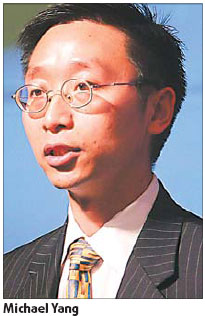Taste of the Big Apple
Updated: 2007-09-06 06:26

Six Chinese companies were listed on the New York Stock Exchange (NYSE) in the first six months of this year and more are expected to follow in the second half of 2007. Michael Yang, the executive director of NYSE Group Asia-Pacific shares his views on the prospects of Chinese companies listing in the United States.
Q: The US stock market has seen many Chinese solar energy companies go public since 2005, but the recent share performance of those firms has not been as good as before. Why?
A: Indeed, there is a global correction for the solar energy sector in capital markets. On the one hand, costs of raw materials for solar energy products increased. A few governments also adjusted their preferential policies in the industry.
Also, quite a number of solar power firms launched IPOs on the US stock market beginning in the second half of last year. Suzhou-based CSI Solar Technologies Inc, Changzhou-based Trina Solar Ltd and Nantong-based Solarfun Power Holding Co Ltd were listed in the second half of last year, while Hebei-based JA Solar Holding Co Ltd, CEEG (Nanjing) PV-Tech Co Ltd, LDK Solar Co Ltd and Yingli Green Energy Holding Co Ltd got listed in the first half of this year. The frequency might have diluted investors' interest in the industry.
Most importantly, if you compare the pricing of LDK and Yingli, you'll find the valuation (price-earnings ratio) of IPO prices for both were much higher than that of their peer companies because of their leading position in the solar power industry. Therefore it is not a surprise their share prices saw some correction recently. However, in the long run, I believe investors will find their intrinsic value.
Q: To what types of (Chinese) firms do US investors' interests now turn?
A: In the past, it was State-owned enterprises (SOEs) that monopolized resources or Internet companies that copied business models from the US. Now Chinese companies from various industries are all attractive to international investors. Companies now coming to the NYSE are in various sectors such as alternative energy, consumer goods and services, medical care, TMT (technology, media and telecommunication) and manufacturing.
Personally I think Chinese companies carrying a "consumption upgrade" concept will have great potential. Years of economic development has enabled Chinese people to upgrade their consumption power, and that contributed to the success of a series of companies, such as Inner Mongolia Yili Ltd, China Mengniu Dairy Co Ltd and the New Oriental Education and Technology Group.
Q: How many Chinese companies are likely to get listed on the NYSE in the second half of this year?
A: It's hard to tell. Six companies got listed on the NYSE in the first six months. It's estimated that around 30 companies will go public in the US this year or early next year.
These companies are distributed in various industries and various areas of China. Some are even from places I've never heard about before. For example, LDK comes from Xinyu, an unknown town in Jiangxi Province. Yet it launched the biggest Chinese IPO since China Netcom made its debut in the NYSE 2004.
Q: How did you access these companies?
A: It is a bi-directional process. Where to go public is a company's own decision. We have to make sure that it wants to get listed in the US before we access them.
Because we do not have offices on the mainland, it is a little difficult for them to access us. But we want to make sure that every company reaching the NYSE standard will be able to list in the NYSE.
Q: Will you comment on investor relations (IR) and information disclosure of Chinese companies?
A: Generally speaking, the NYSE-listed Chinese companies did a good job on investor relations and information disclosure. Actually the NYSE puts in lots of resources to help Chinese companies on this. Companies such as CNOOC, PetroChina and Suntech got listed with the best IR ratings.
(China Daily 09/06/2007 page59)
|
|
|
||
|
||
|
|
|
|